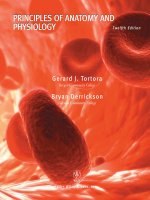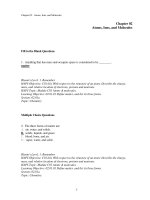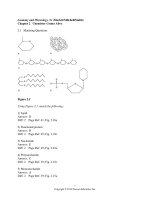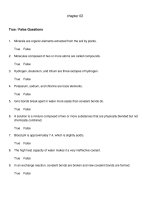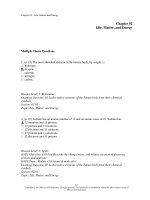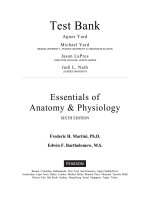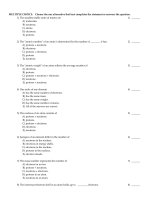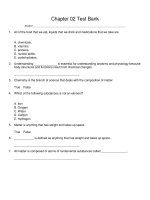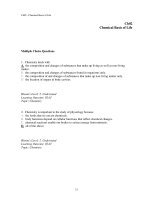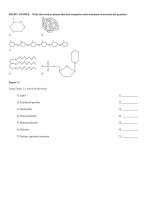principles of anatomy and physiology 14th edition tortora test bank
Bạn đang xem bản rút gọn của tài liệu. Xem và tải ngay bản đầy đủ của tài liệu tại đây (674.27 KB, 39 trang )
Principles of Anatomy and Physiology, 14th Edition Tortora Test Bank
(This is completed downloadable package TEST BANK for Principles of
Anatomy and Physiology, 14th Edition by Gerard J. Tortora , Bryan H.
Derrickson)
Package Title: Testbank
Course Title: PAP 14
Chapter Number: 03
Question type: Multiple Choice
1) What are the three main parts of a eukaryotic cell?
a) plasma membrane, organelles, cytoplasm
b) plasma membrane, organelles, nucleus
c) plasma membrane, cytoplasm, organelles
d) plasma membrane, cytoplasm, nucleus
e) plasma membrane, cytosol, organelles
Answer: d
Difficulty: Medium
Study Objective 1: SO 3.1 Name and describe the three main parts of a cell.
Section Reference 1: Sec 3.1 Parts of a Cell
Question type: Essay
2) Briefly describe the fluid mosaic model.
Answer:
Difficulty: Medium
Study Objective 1: SO 3.2 Describe the structure and functions of the plasma membrane.
Section Reference 1: Sec 3.2 The Plasma Membrane
Solution: The fluid mosaic model states that the molecular arrangement of the plasma membrane
resembles an ever-moving sea of fluid lipids containing a mosaic of many different proteins.
Question type: Multiple Choice
3) The three main components of the lipid bilayer portion of a plasma membrane are
a) phospholipids, glycoproteins, and water.
b) proteins, cholesterol, and fatty acids.
c) cholesterol, triglycerides, and glycolipids.
d) phospholipids, cholesterol, and glycolipids.
e) phospholipids, cholesterol, and proteins.
Answer: d
Difficulty: Medium
Study Objective 1: SO 3.2 Describe the structure and functions of the plasma membrane.
Study Objective 2: SO 3.2.2 Explain the concept of selective permeability.
Section Reference 1: Sec 3.2 The Plasma Membrane
4) What are the nonpolar parts of phospholipids?
a) phosphate-containing head groups
b) fatty acid tail groups
c) Both the head and tail groups are nonpolar.
d) Neither the head nor tail groups are nonpolar.
Answer: b
Difficulty: Medium
Study Objective 1: SO 3.2 Describe the structure and functions of the plasma membrane.
Study Objective 2: SO 3.2.2 Explain the concept of selective permeability.
Section Reference 1: Sec 3.2 The Plasma Membrane
5) The polar portion of a cholesterol molecule, which forms hydrogen bonds with the polar heads
of neighboring phospholipids and glycolipids, consists of a
a) –OH group.
b) –CH3 group.
c) –CH4 group
d) –COOH group
e) None of these choices is correct.
Answer: a
Difficulty: Hard
Study Objective 1: SO 3.2 Describe the structure and functions of the plasma membrane.
Study Objective 2: SO 3.2.2 Explain the concept of selective permeability.
Section Reference 1: Sec 3.2 The Plasma Membrane
6) This type of membrane protein extends across the entire lipid bilayer of the plasma membrane
touching both intracellular fluid and the extracellular fluid.
a) complement protein
b) transmembrane protein
c) peripheral protein
d) lipoprotein
e) All of these choices are correct.
Answer: b
Difficulty: Medium
Study Objective 1: SO 3.2 Describe the structure and functions of the plasma membrane.
Study Objective 2: SO 3.2.2 Explain the concept of selective permeability.
Section Reference 1: Sec 3.2 The Plasma Membrane
Question type: Essay
7) Describe five different functions of integral membrane proteins.
Answer:
Difficulty: Hard
Study Objective 1: SO 3.2 Describe the structure and functions of the plasma membrane.
Study Objective 2: SO 3.2.2 Explain the concept of selective permeability.
Section Reference 1: Sec 3.2 The Plasma Membrane
Solution: Some membrane proteins act as ion channels or carriers that transport substances across
the membrane. Other membrane proteins act as receptors that allow the cell to respond to various
types of ligands. Other membrane proteins are enzymes that catalyze specific chemical reactions.
Still other membrane proteins act as linker proteins that anchor cells to neighboring structures
including other cells. Lastly, some membrane proteins serve as cell identity molecules.
Question type: Multiple Choice
8) This type of membrane protein enables cells to catalyze specific chemical reactions at the inner
or outer surface of their plasma membrane.
a) receptors
b) phospholipids
c) cholesterol
d) enzymes
e) ligands
Answer: d
Difficulty: Medium
Study Objective 1: SO 3.2 Describe the structure and functions of the plasma membrane.
Study Objective 2: SO 3.2.2 Explain the concept of selective permeability.
Section Reference 1: Sec 3.2 The Plasma Membrane
9) Which of the following types of membrane proteins function by recognizing and binding to
hormones and neurotransmitters?
a) transporters
b) receptors
c) enzymes
d) linkers
e) cell identification markers
Answer: b
Difficulty: Medium
Study Objective 1: SO 3.2 Describe the structure and functions of the plasma membrane.
Study Objective 2: SO 3.2.2 Explain the concept of selective permeability.
Section Reference 1: Sec 3.2 The Plasma Membrane
10) This type of membrane protein anchors cells to neighboring cells and to protein filaments found
outside or inside the cell.
a) transporters
b) receptors
c) ligands
d) ion channels
e) linkers
Answer: e
Difficulty: Easy
Study Objective 1: SO 3.2 Describe the structure and functions of the plasma membrane.
Study Objective 2: SO 3.2.2 Explain the concept of selective permeability.
Section Reference 1: Sec 3.2 The Plasma Membrane
11) Plasma membranes are _____, which means that some chemicals move easily through plasma
membrane while other chemicals do not.
a) selectively permeable
b) concentration graded
c) electrically graded
d) selectively soluble
e) electrical insulators
Answer: a
Difficulty: Medium
Study Objective 1: SO 3.2 Describe the plasma membrane structural and functional properties.
Study Objective 2: SO 3.2.2 Explain the concept of selective permeability.
Section Reference 1: Sec 3.3 Transport across the Plasma Membrane
12) Which of the following does NOT influence the rate of diffusion of a chemical across a plasma
membrane?
a) concentration gradient of the chemical across the membrane
b) mass of the diffusing chemical
c) distance that the chemical has to diffuse
d) amount of ATP available
e) temperature
Answer: d
Difficulty: Medium
Study Objective 1: SO 3.3 Describe the processes that transport substances across the plasma
membrane.
Section Reference 1: Sec 3.3 Transport across the Plasma Membrane
Question type: Essay
13) Briefly describe the driving force for the movement of water across plasma membranes.
Answer:
Difficulty: Medium
Study Objective 1: SO 3.3 Describe the processes that transport substances across the plasma
membrane.
Section Reference 1: Sec 3.3 Transport across the Plasma Membrane
Solution: Water moves across membranes by osmosis, which is driven by solute concentration
differences across the membrane. Water moves from the area of low solute concentration to the
area of high solute concentrations.
Question type: Multiple Choice
14) This is a measure of a solution’s ability to change the volume of cells by altering their water
content.
a) filtration
b) normality
c) tonicity
d) equivalency
e) facilitation
Answer: c
Difficulty: Medium
Study Objective 1: SO 3.3 Describe the processes that transport substances across the plasma
membrane.
Section Reference 1: Sec 3.3 Transport across the Plasma Membrane
15) This is the transport process by which gases, like O2 and CO2, move through a membrane.
a) osmosis
b) active transport
c) secondary active transport
d) simple diffusion
e) endocytosis
Answer: d
Difficulty: Medium
Study Objective 1: SO 3.3 Describe the processes that transport substances across the plasma
membrane.
Section Reference 1: Sec 3.3 Transport across the Plasma Membrane
16) In this type of transport process, a solute (e.g. glucose) binds to a specific carrier protein on one
side of the membrane. This binding induces a conformational change in the carrier protein that
results in the solute moving down its concentration gradient to the other side of the membrane.
a) osmosis
b) active transport
c) secondary active transport
d) facilitated diffusion
e) endocytosis
Answer: d
Difficulty: Medium
Study Objective 1: SO 3.3 Describe the processes that transport substances across the plasma
membrane.
Section Reference 1: Sec 3.3 Transport across the Plasma Membrane
17) In this transport process, the energy from hydrolysis of ATP is used to drive substances across
the membrane against their own concentration gradients.
a) primary active transport
b) secondary active transport
c) facilitated diffusion
d) passive diffusion
e) osmosis
Answer: a
Difficulty: Medium
Study Objective 1: SO 3.3 Describe the processes that transport substances across the plasma
membrane.
Section Reference 1: Sec 3.3 Transport across the Plasma Membrane
18) If the solute concentration is greater inside of the cell than outside the cell, water will move by
osmosis
a) into the cell.
b) out of the cell.
c) into and out of the cell at the same rate resulting in no net water movement.
d) All of these answer choices are correct.
e) None of these answers are correct.
Answer: a
Difficulty: Hard
Study Objective 1: SO 3.3 Describe the processes that transport substances across the plasma
membrane.
Section Reference 1: Sec 3.3 Transport across the Plasma Membrane
19) What transport process uses the energy stored in a Na+ or H+ concentration gradient to drive
other substances across the membrane against their own concentration gradients?
a) primary active transport
b) secondary active transport
c) facilitated diffusion
d) passive diffusion
e) osmosis
Answer: b
Difficulty: Medium
Study Objective 1: SO 3.3 Describe the processes that transport substances across the plasma
membrane.
Section Reference 1: Sec 3.3 Transport across the Plasma Membrane
20) Which of the following transport processes uses vesicles that fuse with the plasma membrane to
secrete materials into the extracellular fluid?
a) endocytosis
b) exocytosis
c) facilitated diffusion
d) osmosis
e) Both endocytosis and exocytosis.
Answer: b
Difficulty: Medium
Study Objective 1: SO 3.3 Describe the processes that transport substances across the plasma
membrane.
Section Reference 1: Sec 3.3 Transport across the Plasma Membrane
21) Which of the following transport process uses vesicles formed at the plasma membrane to take
up extracellular substances and import them into the cell?
a) endocytosis
b) exocytosis
c) facilitated diffusion
d) osmosis
e) Both endocytosis and exocytosis.
Answer: a
Difficulty: Medium
Study Objective 1: SO 3.3 Describe the processes that transport substances across the plasma
membrane.
Section Reference 1: Sec 3.3 Transport across the Plasma Membrane
Question type: Essay
22) List the steps involved in receptor-mediated endocytosis.
Answer:
Difficulty: Medium
Study Objective 1: SO 3.3 Describe the processes that transport substances across the plasma
membrane.
Section Reference 1: Sec 3.3 Transport across the Plasma Membrane
Solution: The steps involved in receptor-mediated endocytosis include 1)ligand binding, 2)vesicle
formation, 3)uncoating of the vesicle, 4)fusion of the vesicle with endosome, 5)recycling of
receptors to the plasma membrane, and 6)degradation of the ligand in the lysosome.
Question type: Multiple Choice
23) During phagocytosis, binding of a particle to a plasma membrane receptor triggers formation of
_____, which are extensions of the plasma membrane of the phagocyte that eventually surround the
particle forming a phagosome.
a) podocytes
b) exterior vesicles
c) interior vesicles
d) pseudopods
e) lysosomes
Answer: d
Difficulty: Medium
Study Objective 1: SO 3.3 Describe the processes that transport substances across the plasma
membrane.
Section Reference 1: Sec 3.3 Transport across the Plasma Membrane
24) Which of the following is NOT a characteristic of the cytosol?
a) primarily consists of water
b) cation of electron transport chain carrier proteins
c) site of many important chemical reactions
d) often contains aggregates of triglycerides that form lipid droplets
e) contains the enzymes of glycolysis
Answer: b
Difficulty: Easy
Study Objective 1: SO 3.4 Describe the structure and function of cytoplasm, cytosol, and
organelles.
Section Reference 1: Sec 3.4 Cytoplasm
25) Specialized structures within a cell that have a characteristic shape and perform specific
functions in cellular growth, maintenance and reproduction are called
a) organelles.
b) cytoskeletons.
c) cytoplasm.
d) cytosol.
e) nuclei.
Answer: a
Difficulty: Easy
Study Objective 1: SO 3.4 Describe the structure and function of cytoplasm, cytosol, and
organelles.
Section Reference 1: Sec 3.4 Cytoplasm
26) Microfilaments, intermediate filaments and microtubules are all components of a cell’s
a) cytoskeleton.
b) nucleus.
c) plasma membrane.
d) flagella.
e) ribosome.
Answer: a
Difficulty: Easy
Study Objective 1: SO 3.4 Describe the structure and function of cytoplasm, cytosol, and
organelles.
Section Reference 1: Sec 3.4 Cytoplasm
27) This cellular organelle is comprised of a pair of centrioles and the surrounding pericentriolar
material.
a) cytoskeleton
b) cilia
c) centrosome
d) flagella
e) peroxisomes
Answer: c
Difficulty: Easy
Study Objective 1: SO 3.4 Describe the structure and function of cytoplasm, cytosol, and
organelles.
Section Reference 1: Sec 3.4 Cytoplasm
28) Spermatozoa is the only type of human cell that contains a _____, which is a whip-like
structure that helps propel the sperm towards an oocyte.
a) cilium
b) flagellum
c) mitochondria
d) centrosome
e) microvillus
Answer: b
Difficulty: Easy
Study Objective 1: SO 3.4 Describe the structure and function of cytoplasm, cytosol, and
organelles.
Section Reference 1: Sec 3.4 Cytoplasm
29) Which of the following membrane-enclosed organelles is the site of synthesis of membrane
proteins and secretory proteins?
a) rough endoplasmic reticulum
b) smooth endoplasmic reticulum
c) nucleus
d) centrosome
e) Golgi complex
Answer: a
Difficulty: Medium
Study Objective 1: SO 3.4 Describe the structure and function of cytoplasm, cytosol, and
organelles.
Section Reference 1: Sec 3.4 Cytoplasm
30) Which of the following membrane-enclosed organelles modifies, sorts, and packages proteins
destined for other regions of the cell?
a) endoplasmic reticulum
b) Golgi complex
c) peroxisomes
d) nucleus
e) proteasome
Answer: b
Difficulty: Medium
Study Objective 1: SO 3.4 Describe the structure and function of cytoplasm, cytosol, and
organelles.
Section Reference 1: Sec 3.4 Cytoplasm
Question type: Essay
31) Briefly state the functions of the rough and smooth endoplasmic reticulum.
Answer:
Difficulty: Hard
Study Objective 1: SO 3.4 Describe the structure and function of cytoplasm, cytosol, and
organelles.
Section Reference 1: Sec 3.4 Cytoplasm
Solution: The rough endoplasmic reticulum synthesizes glycoproteins, phospholipids and digestive
enzymes that are transferred to other cellular organelles, inserted into the plasma membrane,
secreted during exocytosis or stored in the lysosomes. The smooth endoplasmic reticulum
synthesizes fatty acids and steroids, detoxifies harmful substances, removes phosphate groups from
glucose-6-phosphate, and stores and releases calcium ions that trigger contractions in muscle fibers.
32) Briefly describe how proteins move through the Golgi complex.
Answer:
Difficulty: Hard
Study Objective 1: SO 3.4 Describe the structure and function of cytoplasm, cytosol, and
organelles.
Section Reference 1: Sec 3.4 Cytoplasm
Solution: Proteins are packaged into transport vesicles by the rough endoplasmic reticulum
membrane. These vesicles enter on the (cis) face of the Golgi complex, and the proteins move
through the cisternae, from (cis) face through to exit (trans) face. Proteins will leave from the
(trans) face of the Golgi complex in vesicles that will deliver the protein to plasma membrane,
secretory vesicles, or to other organelles in the cell.
Question type: Multiple Choice
33) Which of the following membrane-enclosed organelles contains several oxidases that are
involved in oxidation of fatty acids and amino acids during normal metabolism and in
detoxification of chemicals like alcohol in the liver?
a) peroxisomes
b) mitochondria
c) proteasome
d) ribosomes
e) lysosomes
Answer: a
Difficulty: Medium
Study Objective 1: SO 3.4 Describe the structure and function of cytoplasm, cytosol, and
organelles.
Section Reference 1: Sec 3.4 Cytoplasm
34) Which of the following membrane-enclosed organelles can engulf a worn-out organelle, digest
its chemical components, and recycle those digested components?
a) peroxisomes
b) mitochondria
c) proteasome
d) ribosomes
e) lysosomes
Answer: e
Difficulty: Medium
Study Objective 1: SO 3.4 Describe the structure and function of cytoplasm, cytosol, and
organelles.
Section Reference 1: Sec 3.4 Cytoplasm
35) The major function of mitochondria is to
a) move the cell.
b) generate ATP.
c) produce proteins.
d) oxidize organelles.
e) synthesize glycolipids.
Answer: b
Difficulty: Medium
Study Objective 1: SO 3.4 Describe the structure and function of cytoplasm, cytosol, and
organelles.
Section Reference 1: Sec 3.4 Cytoplasm
36) Which of the following protects the contents of the nucleus?
a) nucleic acids
b) nuclear membrane
c) centrosome
d) cilia
e) Golgi complex
Answer: b
Difficulty: Easy
Study Objective 1: SO 3.5 Describe the structure and function of the nucleus.
Section Reference 1: Sec 3.5 Nucleus
37) What is the major function of histones?
a) needed for helix formation of the DNA
b) add negative charge to the DNA
c) help organize coiling and folding of the DNA
d) degrade faulty proteins in the nucleus
e) catalyze methylation of the DNA
Answer: c
Difficulty: Medium
Study Objective 1: SO 3.5 Describe the structure and function of the nucleus.
Section Reference 1: Sec 3.5 Nucleus
Question type: Essay
38) Briefly explain the difference between transcription and translation.
Answer:
Difficulty: Medium
Study Objective 1: SO 3.6 Describe the sequence of events in protein synthesis.
Section Reference 1: Sec 3.6 Protein Synthesis
Solution: Transcription is making mRNA from DNA and it occurs in the nucleus, while translation
is making a protein from the information in mRNA and happens in the cytosol of the cell.
Question type: Multiple Choice
39) This portion of a DNA segment does not code for a protein.
a) RNA
b) introns
c) exons
d) polyribosome
e) ribosome
Answer: b
Difficulty: Medium
Study Objective 1: SO 3.6 Describe the sequence of events in protein synthesis.
Section Reference 1: Sec 3.6 Protein Synthesis
Question type: Essay
40) Briefly describe alternative splicing.
Answer:
Difficulty: Medium
Study Objective 1: SO 3.6 Describe the sequence of events in protein synthesis.
Section Reference 1: Sec 3.6 Protein Synthesis
Solution: Alternative splicing of mRNA is a process in which the pre-mRNA transcribed from a
gene is spliced in different ways to produce several different mRNAs. The different mRNAs are
used to make different proteins.
Question type: Essay
41) Define homologous chromosomes.
Answer:
Difficulty: Easy
Study Objective 1: SO 3.7 Understand the events and processes involved in cell division.
Study Objective 2: SO 3.7.1 Discuss the stages, events, and significance of somatic and
reproductive cell division.
Section Reference 1: Sec 3.7 Cell Division
Solution: Homologous chromosomes contain similar genes arranged in the same (or almost the
same) order.
Question type: Multiple Choice
42) During this phase of cell division, organelles duplicate and centrosome replication begins.
a) interphase
b) prophase
c) metaphase
d) anaphase
e) telophase
Answer: a
Difficulty: Medium
Study Objective 1: SO 3.7 Understand the events and processes involved in cell division.
Study Objective 2: SO 3.7.1 Discuss the stages, events, and significance of somatic and
reproductive cell division.
Section Reference 1: Sec 3.7 Cell Division
43) During this phase of cell division, the centromeres split leading to separation and subsequent
migration of the two members of a chromatid pair to opposite poles of the cells. The cleavage
furrow also begins to develop during this phase.
a) interphase
b) prophase
c) metaphase
d) anaphase
e) telophase
Answer: d
Difficulty: Medium
Study Objective 1: SO 3.7 Understand the events and processes involved in cell division.
Study Objective 2: SO 3.7.1 Discuss the stages, events, and significance of somatic and
reproductive cell division.
Section Reference 1: Sec 3.7 Cell Division
44) In the diagram, which organelle is responsible for autophagy and autolysis?
a) C
b) B
c) F
d) J
e) D
Answer: a
Difficulty: Medium
Study Objective 1: SO 3.4 Describe the structure and function of cytoplasm, cytosol, and
organelles.
Section Reference 1: Sec 3.4 Cytoplasm
45) In the diagram, which organelle is used to modify, sort and transport proteins?
a) D
b) I
c) A
d) J
e) G
Answer: d
Difficulty: Medium
Study Objective 1: SO 3.4 Describe the structure and function of cytoplasm, cytosol, and
organelles.
Section Reference 1: Sec 3.4 Cytoplasm
46) In the diagram, which organelle aids movement of the cell?
a) A
b) G
c) H
d) D
e) I
Answer: a
Difficulty: Medium
Study Objective 1: SO 3.4 Describe the structure and function of cytoplasm, cytosol, and
organelles.
Section Reference 1: Sec 3.4 Cytoplasm
47) In the diagram, this structure directs cellular activities.
a) D
b) F
c) G
d) A
e) H
Answer: c
Difficulty: Medium
Study Objective 1: SO 3.5 Describe the structure and function of the nucleus.
Section Reference 1: Sec 3.5 Nucleus
48) In the diagram, which one represents carrier-mediated facilitated diffusion?
a) A
b) B
c) C
d) Both A and C
e) Both B and C
Answer: c
Difficulty: Easy
Study Objective 1: SO 3.3 Describe the processes that transport substances across the plasma
membrane.
Section Reference 1: Sec 3.3 Transport across the Plasma Membrane
49) In the diagram, which one represents a hypertonic solution
a) A
b) B
c) C
d) Both B and C
e) All of these choices are correct.
Answer: c
Difficulty: Easy
Study Objective 1: SO 3.3 Describe the processes that transport substances across the plasma
membrane.
Section Reference 1: Sec 3.3 Transport across the Plasma Membrane
Question type: Essay
50) Describe briefly what is occurring at each step in the figure.
Answer:
Difficulty: Hard
Study Objective 1: SO 3.6 Describe the sequence of events in protein synthesis.
Section Reference 1: Sec 3.6 Protein Synthesis
Solution: This figure represents protein synthesis. Step one, the initiator tRNA attaches to a start
codon. In step two, the large and small ribosomal subunits join to form a functional ribosome and
initiator tRNA fits into P site. In step three, the anticodon of an incoming tRNA pairs with the next
mRNA codon at A site. Step four, the amino acid on the tRNA at P site forms a peptide bond with
the amino acid at A site. Step five, the tRNA at the P site leaves the ribosome and the ribosome
shifts down by one codon. The tRNA previously at the A site is now at the P site. Step six is when
protein synthesis stops when the ribosome reaches one of three potential stop codons on the mRNA
strand.
Question type: Multiple Choice
51) In the diagram, which panel shows events occurring during anaphase?
a) A
b) B
c) C
d) D
e) E
Answer: d
Difficulty: Easy
Study Objective 1: SO 3.7 Understand the events and processes involved in cell division.
Study Objective 2: SO 3.7.1 Discuss the stages, events, and significance of somatic and
reproductive cell division.
Section Reference 1: Sec 3.7 Cell Division
52) In the diagram, which panel shows the kinetochore of the centromeres aligning along the center
of the mitotic spindle of the cell?
a) A
b) B
c) C
d) D
e) E
Answer: c
Difficulty: Easy
Study Objective 1: SO 3.7 Understand the events and processes involved in cell division.
Study Objective 2: SO 3.7.1 Discuss the stages, events, and significance of somatic and
reproductive cell division.
Section Reference 1: Sec 3.7 Cell Division
53) In the diagram, which panel shows cells that are in interphase?
1A
2C
3F
a) 1 only
b) 2 only
c) 3 only
d) 1 and 3
e) 1, 2, and 3
Answer: d
Difficulty: Easy
Study Objective 1: SO 3.7 Understand the events and processes involved in cell division.
Study Objective 2: SO 3.7.1 Discuss the stages, events, and significance of somatic and
reproductive cell division.
Section Reference 1: Sec 3.7 Cell Division
Question type: Essay
54) Compare and contrast primary and secondary active transport.
Answer:
Difficulty: Medium
Study Objective 1: SO 3.3 Describe the processes that transport substances across the plasma
membrane.
Section Reference 1: Sec 3.3 Transport across the Plasma Membrane
